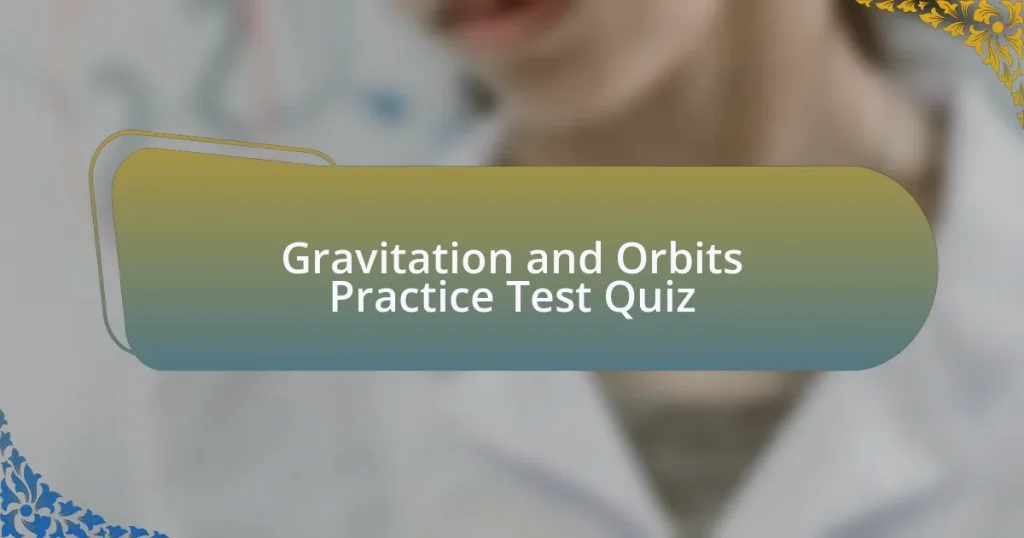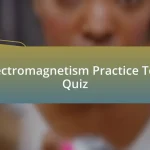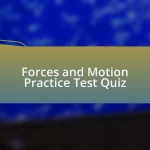Start of Gravitation and Orbits Practice Test Quiz
1. Who formulated the law of universal gravitation?
- Albert Einstein
- Isaac Newton
- Johannes Kepler
- Galileo Galilei
2. What is the force of gravity between two objects proportional to?
- The difference of their masses and directly proportional to the distance between them.
- The square of their velocities multiplied by the distance between them.
- The sum of their masses divided by the distance between them.
- The product of their masses and inversely proportional to the square of the distance between them.
3. What is the SI unit of gravitational force?
- Ampere (A)
- Pascal (Pa)
- Joule (J)
- Newton (N)
4. According to the theory of general relativity, what causes gravity?
- The mass of objects
- The speed of light
- The curvature of spacetime
- Electromagnetic forces
5. Which celestial body is responsible for the tides on Earth?
- The Moon
- Jupiter
- Mars
- The Sun
6. What is the approximate acceleration due to gravity on the surface of Earth?
- 8.0 m/s^2
- 10.5 m/s^2
- 12.2 m/s^2
- 9.8 m/s^2
7. What happens to the gravitational force between two objects if the distance between them is doubled?
- It remains the same
- It is tripled
- It is doubled
- It is halved
8. Which planet has the highest surface gravity in our solar system?
- Jupiter
- Mars
- Earth
- Saturn
9. Which of the following is a unit of gravitational potential energy?
- Pascal (Pa)
- Newton (N)
- Watt (W)
- Joule (J)
10. What happens to the gravitational force between two objects if the mass of one object is doubled?
- It is halved
- It remains unchanged
- It is doubled
- It becomes zero
11. What is the escape velocity?
- The maximum speed of a rocket
- The velocity of a falling object
- The velocity required to leave the atmosphere of a planet
- The speed of sound in air
12. Which of the following is true about gravitational potential energy?
- It is independent of the object`s mass and height
- It decreases with increasing height above the ground
- It depends on the mass of the object and the distance from the center of the Earth
- It is only affected by the object`s velocity
13. Which scientist first proposed the concept of black holes?
- Isaac Newton
- Karl Schwarzschild
- Stephen Hawking
- Albert Einstein
14. Which of the following factors affects the strength of the gravitational field around an object?
- The size of the object, the weight of the object, and the brightness of the object
- The color of the object, the temperature of the object, and the smell of the object
- The mass of the object, the distance from the object, and the shape of the object
- The age of the object, the texture of the object, and the sound of the object
15. Which planet has the least amount of gravitational force compared to Earth?
- Pluto
- Venus
- Mercury
- Mars
16. What is the term for the phenomenon where light is bent as it passes through a gravitational field?
- Light diffraction
- Reflection
- Refraction
- Gravitational lensing
17. Which of the following statements is true about the relationship between mass and weight?
- Weight is independent of gravitational acceleration.
- Weight is the force exerted by gravity on an object, which depends on both mass and gravitational acceleration.
- Weight is only determined by the object`s volume.
- Mass and weight are the same physical quantity.
18. What is the term for the point in an object’s trajectory where it is closest to the body it is orbiting?
- Nadir
- Perigee
- Zenith
- Apogee
19. Which of the following factors does NOT affect the gravitational force between two objects?
- Distance between the centers
- Mass of the objects
- Shape of the objects
- Charge of the objects
20. According to Kepler’s first law, what is the shape of a planet’s orbit?
- An ellipse with the Sun at one focus
- A rectangular shape
- A perfect circle
- A straight line
21. According to Kepler’s second law, what does a planet sweep out in its orbit?
- Constant speed
- Equal areas in equal time intervals
- Circular paths
- Perpendicular distances
22. According to Kepler’s third law, what is the relationship between a planet’s orbital period and its distance from the Sun?
- The orbital period is equal to the distance from the Sun.
- The square of the orbital period is proportional to the cube of the semi-major axis of the orbit.
- The orbital period is inversely proportional to the distance from the Sun.
- The distance from the Sun is irrelevant to the orbital period.
23. How would the period of an object in a circular orbit change if the radius of the orbit doubled?
- The period would increase by a factor of 4
- The period would decrease by a factor of 2
- The period would increase by a factor of 2
- The period would remain the same
24. If you were to stand on a bathroom scale in an elevator that is accelerating downward, the bathroom scale would measure?
- No reading at all
- A lower reading than your actual weight
- The same reading as your actual weight
- A higher reading than your actual weight
25. Explain why an astronaut in orbit experiences apparent weightlessness.
- Because the spacecraft generates enough thrust to counteract gravity.
- Because the astronaut is wearing a special suit that nullifies weight.
- Because the astronaut experiences no gravitational pull in space.
- Because the astronaut and the spacecraft are both in free fall around the Earth, and there is no net force acting on them in the direction of the gravitational field.
26. A satellite with a mass of 2.5 × 10^3 kg orbits Earth at an altitude of 139 km. Calculate the orbital period and orbital speed of the satellite.
- Orbital period ≈ 3 hours, Orbital speed ≈ 5 km/s
- Orbital period ≈ 2 hours, Orbital speed ≈ 6.5 km/s
- Orbital period ≈ 1.5 hours, Orbital speed ≈ 7.5 km/s
- Orbital period ≈ 1 hour, Orbital speed ≈ 8 km/s
27. If an object is orbiting around a planet and all of a sudden gravity disappears, in what direction will the satellite continue moving?
- The satellite will continue moving in a straight line tangent to its original orbit
- The satellite will move back toward its starting point
- The satellite will spiral inward toward the planet
- The satellite will fall straight down to the planet
28. TRUE or FALSE: For every planetary orbit in our solar system, the Sun is at the center of each of these orbits.
- FALSE
- VARIABLE
- TRUE
- NOT POSSIBLE
29. What is the term for the force that keeps planets in their orbits?
- Electromagnetic force
- Centripetal force
- Gravity
- Frictional force
30. What is the term for the force that causes planets to collide with each other?
- Gravity
- Electromagnetism
- Friction
- Magnetism
Congratulations! You’ve Successfully Completed the Quiz!
Well done on completing the ‘Gravitation and Orbits Practice Test’! This quiz has been designed to challenge your understanding of key concepts related to gravitation and orbital mechanics. You’ve engaged with fundamental principles like Newton’s law of gravitation, the concept of escape velocity, and the behavior of celestial bodies in space. Each question was an opportunity to deepen your physics knowledge and enhance your problem-solving skills.
Throughout this quiz, you may have discovered new insights about how gravity shapes our universe. You likely learned how gravitational forces affect the motion of planets, moons, and other objects in space. Understanding these concepts is essential for anyone looking to excel in physics. This foundational knowledge not only boosts your test scores but also ignites a curiosity about the world beyond our planet.
If you’re eager to learn more, we invite you to explore the next section on this page dedicated to ‘Gravitation and Orbits.’ Here, you will find further information and resources to expand your understanding of these captivating topics. With each new piece of knowledge, you can prepare yourself better for future physics exams and scientific discussions. Keep up the great work!
Gravitation and Orbits Practice Test
Understanding Gravitation in Physics
Gravitation is a fundamental force that governs the attraction between masses. It explains how objects exert force on one another, influencing their motion in various contexts. Sir Isaac Newton formulated the universal law of gravitation, stating that every particle attracts every other particle with a force proportional to the product of their masses and inversely proportional to the square of the distance between their centers. This principle is crucial in understanding planetary motion, satellite trajectories, and more, thus forming a core component of physics education.
The Role of Orbits in Gravitational Theory
Orbits are the paths objects take as they move under the influence of gravitational attraction. In the context of celestial bodies, an orbit arises when a body moves around a larger mass due to gravity. For instance, planets orbit stars, and moons orbit planets. Kepler’s laws of planetary motion describe these orbits, detailing their elliptical shapes and the relationship between their periods and distances from the central body. Understanding orbits is essential for predicting celestial movements and satellite behavior.
Types of Orbits and Their Characteristics
Orbits can be categorized into several types based on their characteristics and applications. The most common types include circular, elliptical, parabolic, and hyperbolic orbits. Circular orbits maintain a constant distance from the central body, while elliptical orbits vary in distance, making them more complex. Parabolic and hyperbolic paths relate to objects that approach or escape gravitational influence. Understanding these types helps in fields like space exploration, satellite deployment, and astrophysics.
Gravitation and Orbital Mechanics in Practice Tests
Practice tests in gravitation and orbital mechanics typically focus on applying concepts and equations to solve problems. These tests often include questions on calculating gravitational force, determining orbital speeds, and analyzing the effects of changing mass or distance on gravitational interaction. Familiarity with formulas, such as Newton’s law of gravitation and centripetal force equations, is essential. Practicing these problems equips students with the skills needed to tackle similar questions on actual exams.
Common Mistakes in Gravitation and Orbits Problems
Students often make mistakes in gravitation and orbit problems due to misunderstandings of key concepts. Misapplying the law of universal gravitation, neglecting the effects of additional forces, or incorrectly interpreting orbital energy can lead to errors. Additionally, confusing the relationships defined by Kepler’s laws or failing to account for non-circular orbits can result in incorrect answers. Awareness of these common pitfalls enhances problem-solving accuracy and performance on assessments.
What is gravitation?
Gravitation is a fundamental force that attracts two bodies with mass toward each other. Sir Isaac Newton formulated the law of universal gravitation, which states that every mass attracts every other mass in the universe with a force directly proportional to the product of their masses and inversely proportional to the square of the distance between their centers. This law is essential in understanding the motion of planets, moons, and other celestial objects within orbits.
How do orbits form around celestial bodies?
Orbits form due to the balance between the gravitational force acting on an object and its inertia. When an object moves horizontally at a certain speed, gravity pulls it towards the larger mass, while inertia keeps it moving forward. This balance results in the object’s continuous path around the larger body, creating an orbit. For example, Earth orbits the Sun because the gravitational pull from the Sun and Earth’s velocity maintain this balance.
Where can one find resources for gravitation and orbits practice tests?
Resources for gravitation and orbits practice tests can be found in various online educational platforms such as Khan Academy, Quizlet, and Coursera. Additionally, bookstores and libraries often have physics textbooks that include practice problems and tests on gravitation and orbits. Many university websites also offer free access to practice problems and previous exam papers for students.
When is gravitation most noticeable in daily life?
Gravitation is most noticeable in daily life when objects fall to the ground due to the gravitational pull of the Earth. This force also affects tides, as the Moon’s gravity influences ocean levels. The effects of gravity are fundamental to various activities, such as walking, driving, and any movement that requires support against the Earth’s pull.
Who discovered the law of universal gravitation?
Sir Isaac Newton discovered the law of universal gravitation in the late 17th century. He published his findings in the book “Mathematical Principles of Natural Philosophy” in 1687. This landmark work laid the foundation for classical mechanics and described how gravity governs the motion of celestial bodies, which remains valid for most practical applications today.















